For the most part, saltwater pools are still overwhelmingly popular. Still, we come across many pool owners who have questions on how to convert an above ground pool to saltwater. Although the overall concept is the same as inground pools, there are slight differences that are definitely worth mentioning. Additionally, we also cover what a salt pool is, the benefits and drawbacks of having one, and how to size one for your pool.
In short, hopefully, this is a one-stop information shop for your questions about converting your above ground pool to saltwater.
What Exactly Is A Salt Pool?
Before the critics jump into the comment section to correct us, we understand that the name itself may be a tad misleading. A salt pool is an alternative option to the standard chlorinated swimming pool. As water passes through the cell, electrolysis occurs.
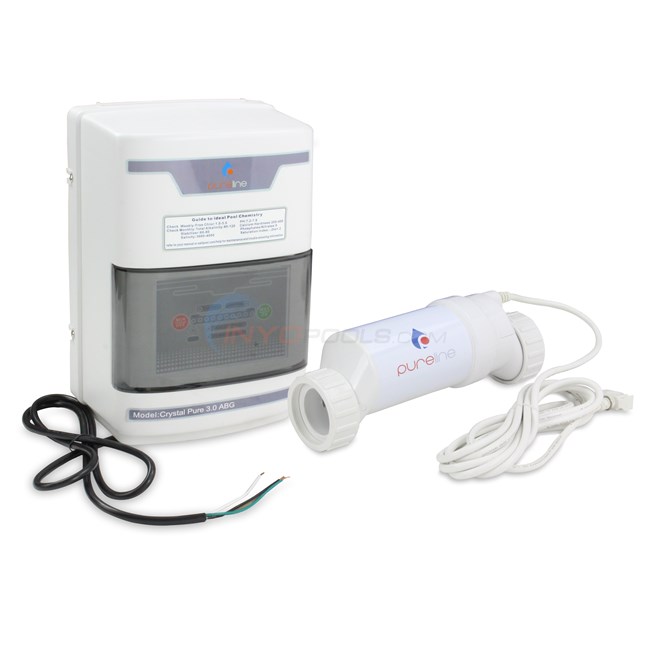 Electrolysis is the process in which the salt and water split into hydrogen and hypochlorous acid and converts to chlorine. Sure, you are still using chlorine to sanitize your pool, however, it’s just in a different form.
Electrolysis is the process in which the salt and water split into hydrogen and hypochlorous acid and converts to chlorine. Sure, you are still using chlorine to sanitize your pool, however, it’s just in a different form.
Another thing that might be misleading is the idea that a salt pool mimics water you find at the beach. Although I do love the beach, this is inaccurate. To compare, ocean water is at 50,000 parts per million (PPM) while a salt pool sits close to 3,000 ppm. Therefore, it is only a fraction of the amount of salt you find at the beach. The cool thing about salt systems is once the chlorine finally breaks down, it becomes salt again.
The chlorine produced by salt is a higher quality than the traditional chlorine. By converting to a salt pool, you no longer need to purchase chlorine tablets, liquid chlorine, or shock.

The Pros and cons of Salt Pools
Pros
- Gentle on your eyes and skin. The chlorine produced by salt systems do not have negative effects on your skin and eyes like traditional chlorine. By comparison, it is softer to swimmers’ eyes, skin, and hair and does not produce a harsh chlorine smell. It is perfect for pool owners whose bodies react to harsh chemicals.
- No need to buy chlorine. Since your salt system will produce the chlorine for your pool, you no longer have to spend money on chlorine tablets, liquid chlorine, or shock.
- Less pool maintenance. You can control the chlorine levels from a dial on the salt system itself. Now, you don’t have to worry about adding chlorine to your pool every week. However, you must continue to check your chlorine levels for balance. Many pool owners find this as the greatest benefit.
Cons
- It can be corrosive to your pool and pool equipment. Corrosiveness is one of the biggest concerns pool owners have about salt systems. A well-balanced pool with a salt system should not rust your above ground pool parts. In fact, the water shouldn’t touch the actual pool itself. However, small holes and tears in a pool liner can cause premature rusting if the water comes into contact with your pool. Also, in our experience, we noticed that the shaft seal on your pool pump may fail quicker than normal. If you are adding a heater to your pool, consider purchasing a cupro-nickel heater. The heavy-duty heat exchanger withstands corrosion a lot better than a standard heater. The last item you might consider is a sacrificial zinc anode. You place this zinc disk in your skimmer and the anode absorbs all the corrosion
For more information on zinc anodes, check out our Poolside Chat video HERE.
- Costs of replacement cells. The longevity of your salt cell varies on a few different factors. It is very important to balance and maintain your pool’s water chemistry and to properly size your salt system. If you oversize your salt system, you will find yourself replacing your cell less often. Still, depending on the size of your cell, the costs can range between $200-$700. Most pool owners replace their cell every 3 to 7 years.
- Higher pH and calcium build-up. In salt pools, the pH tends to rise. High levels of pH can lead to calcium scaling in your pool or your salt cell.
How To Convert an Above Ground Pool to Saltwater
A saltwater generator is comprised of two parts, a power supply, and a salt cell. Most pool owners wire their power supply at the equipment pad while the salt cell plumbs inline with the return jet or through hard pipe installation.
Selecting Your Salt System
Before purchasing your salt system, there are a few things you want to consider. First, make sure you know how many gallons of water your pool holds. If you are unsure, you can check a pool volume calculator HERE.
Next, you want to determine which type of plug setup you have for your pool area. Lastly, think about how you intend on installing it to your pool.

Plug Type
There are two different types of plugs for above ground salt systems: the standard 3-prong and twist lock. Selecting the wrong type of cord can delay your installation. You can determine which plug you need by looking at your current above ground pool set up.
You can find the three-prong plug on most household appliances. The Twist Lock plugs aren’t as popular and you typically see more of them in the Northeastern part of the US.
Fitting Type
Depending on the make and model of the salt system, you can mount the cell to your plumbing lines one of two ways, the return jet (RJ) or the hose/pipe (HP). With the use of adapters and flex hose, you install the RJ units vertically under the return jet. There is an additional elbow that hooks into the return line. Because of the design, there is no need for a flow switch.
The HP units install directly into PVC pipe or pool hose. You have the ability to install these units vertically or horizontally. In some salt systems like the Pureline Crystal Pure, the cell easily plumbs in-line and has quick disconnect unions for easy access.
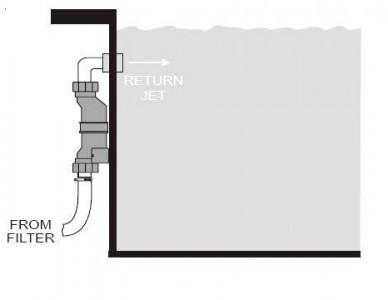
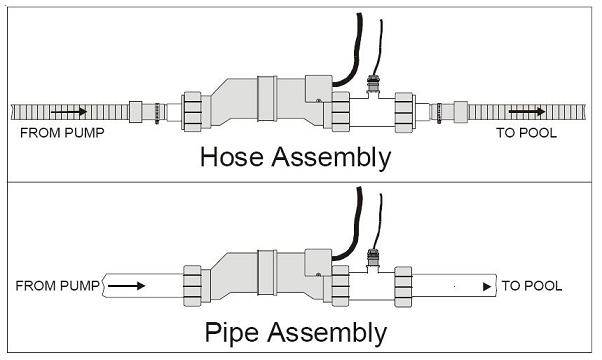
Pool Size
Above ground salt systems typically range from 10,000 gallons to around 20,000 gallons. You choose a salt system based on how many gallons of water your pool holds. Like your pool filter, we highly recommend oversizing your salt system. The larger units allow pool owners to run their salt systems for shorter periods of time, preserving the longevity of the salt cell. As a result, you aren’t replacing your salt cell as often.
For more information, check out our blog article, How Do I Choose the Right Salt Chlorine Generator?
Features
The features you find in above ground pool salt systems vary. Some features include salt readout, digital display, self-cleaning, built-in timer to power your pump, water flow detector, and low salt and overload indicators.
Where to Buy
You can purchase above ground pool salt systems on our website. Currently, we offer the Crystal Pure systems and the Aqua Trol systems.

Installation
Are you installing the unit yourself or are you hiring a pool professional?
Most pool owners can install their above ground salt system themselves. However, hiring a pool technician should always be an option. Based on research, we found that the average price for installing a salt system ranges from $300 to $500.
Unlike pool equipment like heaters and automation systems, a pool owner can install their system without fear of losing their warranty. In fact, many of the above ground salt system manufacturers boast that you can install their system in less than an hour. Although the installation process is less intense than if you were installing an inground unit, ultimately, the decision is yours.
Starting Your Salt System
 Before you adjust any of your chemical levels, it is essential to first test your water. We offer different pool water testing equipment on our site that you can use. Maintain your water between the following values:
Before you adjust any of your chemical levels, it is essential to first test your water. We offer different pool water testing equipment on our site that you can use. Maintain your water between the following values:
Salt: 2700 -3400 ppm
Free Chlorine: 1-3 ppm
pH: 7.2-7.6
Cyanuric Acid (Stabilizer): 70-80 ppm (covered pools is 20-40 ppm)
Total Alkalinity: 60-80 ppm
Calcium Hardness: 200-400 ppm
Water Chemistry For Saltwater Pools
Additionally, our blog article, Water Chemistry For Saltwater Pools, is available for pool owners to review. It is a chemical quick start-up guide for saltwater pools that guides you through adjusting your chemical levels.
Adding Salt
After you install your salt system, the next step is adding salt. To help with this process, we created a comprehensive guide on how to add salt to your pool. In the video below, we touch on the type of salt to use, how much salt to add, and how to add it.
Although the video uses an inground pool, you can use the same process to add salt to your above ground pool.
Feel free to access the written how-to guide for the How To Add Salt to Your Pool video HERE.
Common Salt Conversion FAQ’s
Of the many topics we cover, salt is one of the most popular and yields the most questions.
- Do I need to drain my pool? No, you do not need to drain your pool. The residual chlorine does not affect your new salt cell. Of course, you can if you want, however, it is not necessary.
- Does salt come with the system? No, salt does not come with the system. You will need to pick up salt from your local home improvement store, pool store, or grocery store. Make sure to purchase granular salt with at least 99.8% NaCl. (No pellets or rock salt.)
- Will I need any additional equipment? No, you do not need any additional equipment to operate the salt system. However, if you have metal exposed to water, you may want to invest in a zinc anode.
- Are saltwater pools salty? No, the water from a saltwater system will not taste like salt. The amount of salt you can find in a saltwater pool does not reach the human salt threshold. For a better explanation, click HERE.
Best Salt System For Above Ground Pools
If you are looking for a salt system for your above ground pool that won’t break your pockets, we recommend the Pureline Crystal Pure. The Crystal Pure is a reliable salt system that frees pool owners from intense chemical maintenance while giving swimmers a break from traditional chlorine. The Crystal Pure generator cell easily plumbs in-line and has quick disconnect unions for easy access.
Need Help Converting Your Above Ground Pool to Salt?
If you have questions about converting to salt, sizing your salt system, or any maintenance issues, please feel free to reach out to us. You can reach us by phone at 407-834-2200 or by leaving a question for us in the comment section.

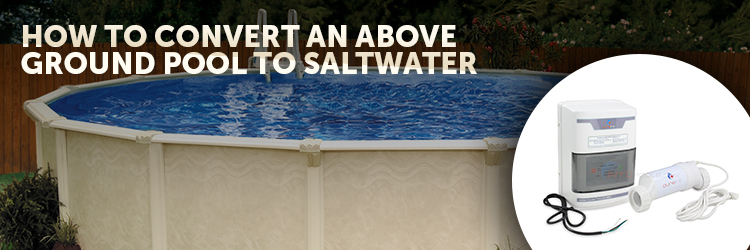
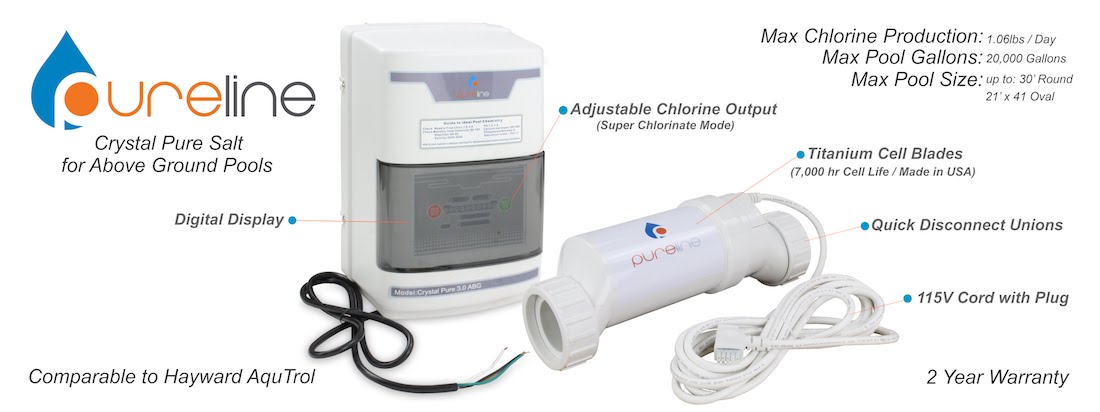
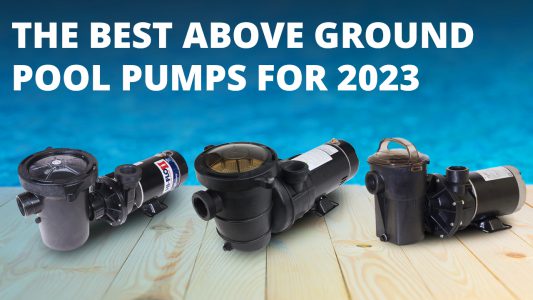
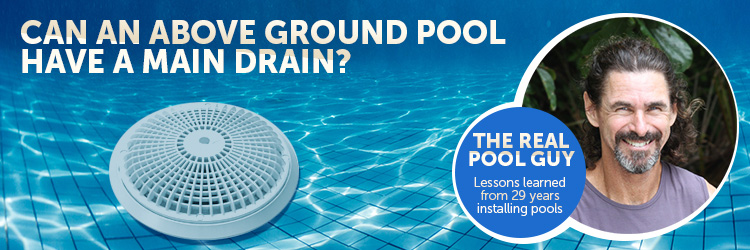

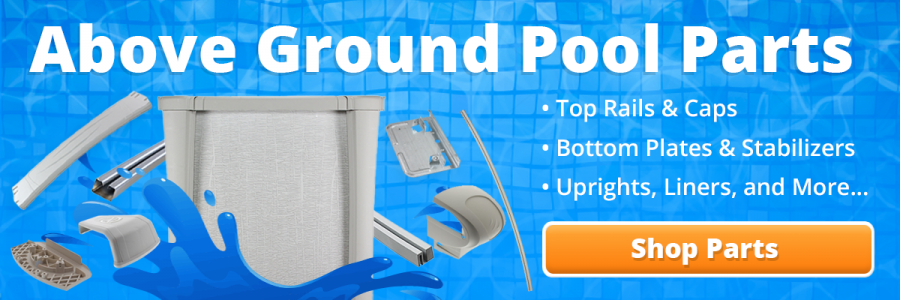






I have a intex 16×25 pool. The frame is plastic resin. I want to convert from sand to salt water. What do I need to buy? The filter system looks the same as sand. So I don’t wanna spend money on stuff I don’t need
I have a 15×42 Polygroup Summerwaves pool. Frame is metal but pool itself is not. I’m using a Sand Shark Filter System 1/2HP Motor and pump. Can I easily convert to a saltwater pool?
I have a Doughboy above ground 24×52 chlorine pool and I want to convert to salt. This is not resin, but steel. Can this be done?
No, it should not be converted to salt.
We just ordered a 10ft x 30” inflatable ring top pool and we are looking at making it a salt water pool. What kind of pump and other supplies do we need? It comes with a 600gph filter pump.
I have a summer waves 16x 48 pool and I want to convert th as t to saltwater. Any suggestions? I’ve read and watched videos and I’m just not certain what to purchase.
Is your Summar Wave a steel frame pool or a soft-sided construction with a plastic frame?
Wr have a Coleman 18×48 above ground, can these type of pools be converted to salt water?
If it is a steel wall and frame pool, no. Coleman makes a lot of pools, so I can’t tell which model you have based on that info. It’s akin to saying “I have a Ford”
Is it a steel or resin pool? If it is steel, no; if it resin, yes.
I have a soft sided construction polygroup pool. I would like to convert it to a salt water pool also.
Can a salt water system be added to any above ground pool ? I was told by the pool store is wasn’t recommended for my pool because it will mess it up
Salt is corrosive to steel, so if your pool is composed of steel top rails, rims, top caps, and bottom plates, then I would skip the salt system. Resin and hybrid pools are considered the “salt-friendly” option
I’m looking to make an intex 8ft x 30in inflatable ring top pool a saltwater pool. Do you have any recommendations for a cheaper salt water pump for a pool that size?
I am wondering the same thing! Anyone have an answer?
I have a 15’ x 30’ Vogue pool. It has steel sides and resin top rails and exterior braces. Can it be converted to a salt system?
Is there any advice on compatibility between the board itself and what type of cell your using. I.E. Hayward turbo cell GLX cell 5 vs T-5. I recently had to get a new panel and my old GLX cell 5 doesn’t seem to work with the new Board, thus forcing me to use the cell the new board came with.
Thanks
To my knowledge, there is no difference between the old T-CELLs and the GLX. Essentially, the only thing that changed was the model numbers. Maybe you got a bad cell?